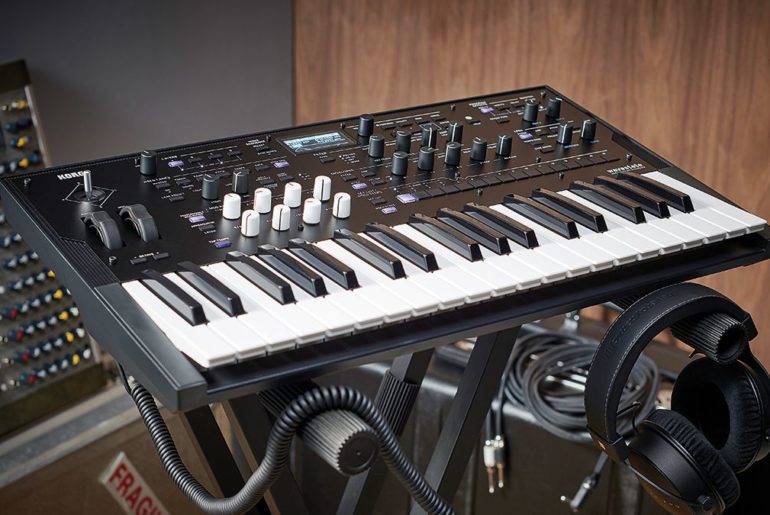Born out of the ashes of Sequential and their Prophet VS vector synth, the original Korg Wavestation was one of the defining instruments of the early ’90s.
Key to the Wavestation’s character were two elements: the vector synthesis inherited from Sequential, which allowed users to crossfade between four separate waves, and its own wave-sequencing engine, whereby multiple waves can be assigned to a sound sequentially to create evolving timbres, patterns or even simple drum grooves. It proved popular, particularly with ambient and soundtrack producers, or those simply looking for a ready source of interesting pad sounds.
Wavestate sits on the spectrum between a remake and a sequel. On the one hand, this is very much designed to capture the sound and feel of its predecessor, right down to classic vector joystick and inclusion of a fair few recognisable waves featured on the original (or one of its expansion cards). The Wavestate also expands on the underlying tech in a number of interesting ways though.
Korg is calling the engine here ‘Wave Sequencing 2.0’. As with the original, the Wavestate makes use of multiple sound layers – up to four here – each of which can contain a wave sequence of multiple PCM samples or a standard multisample patch and can be stacked or split across the keyboard.
The main difference here is that the engine uses a system of six lanes allowing sample selection, timing, pitch and modulation to be programmed independently. These allow the source waves and the playback conditions to be sequenced with independent timings or sequence/loop lengths. As a result, you can set up some interesting patterns which seem to transform indefinitely without repeating. Each layer makes use of an optional Master Lane too, which can control and reset the timing of the others. The steps in each lane can also be assigned a probability, which lets the user add an extra element of sonic randomisation.
The vector synthesis element of the original is present too. This allows modulation parameters to be assigned to the four A, B, C and D axis of the vector grid, movement between these can then be controlled manually using the front panel joystick, via the dedicated five-stage, looping vector envelope or via an external MIDI input.
The joystick and envelope work together so that when envelope modulation is engaged, the joystick affects the modulation start position. In its most simple setup, vector modulation can control the relative volume of the four layers, allowing for morphing between four sounds. You can assign the four modulation signals to a whole host of destinations on both individual Layer and global Performance levels though, so the options of what you can achieve with the vector system are extensive.
There’s a lot more to the Wavestate’s modulation options aside from this though, including per-voice envelopes and LFOs for the amp, pitch and filter, plus an additional LFO for pan position (each of the Wavestate’s 64-voices is stereo). There are also six assignable performance, rotaries on the front panel, a complex modulation matrix – allowing for the depth of any routing to be modulated by a secondary source – and a pair of Eurorack-like modulation processors.
There’s one omission on the modulation front though, in that there’s no aftertouch from the built-in keyboard (although it does have velocity and release velocity). The Wavestate receives polyphonic aftertouch via external MIDI, but it’s a shame not to have it built-in.
One of the weaker aspects of the original Wavestation was its filter, which lacked resonance and character. Korg has remedied that here with the inclusion of multiple resonant filter models, including emulations of both the Polysix and MS-20 filters. A front-panel button lets users flip quickly between Polysix LPF, MS-20 LPF and a 2-pole HPF model, as well as a fourth selection labelled ‘more’. This fourth option actually reveals a total of 12 filter models, including multiple 2- and 4-pole variants, both low- and high-pass MS-20 models and a Multi Filter, which effectively offers three filters at once. The Polysix and MS-20 filters have a high gain option too, to emulate filter overdrive.
The final element in the Wavestate’s signal path is a multi-effects processor. This has three effect slots per-layer, labelled Pre-FX, Mod-FX and Delay, plus global Reverb and parametric EQ. There’s a broad range of processing on offer here including a host of chorus, phaser and ensemble modes. There’s a wide variety of emulated delays and reverbs included too, and most of the effects can be modulated from the synth’s main mod matrix. It all adds up to yet more sound-shaping power for an already powerful instrument.
Taken as a whole, the Wavestate is an excellent instrument. Korg has done a fantastic job of walking the line between being faithful to a classic and offering something new. Sonically, the synth nails what Wavestation fans expect – even just as a preset machine, this is an awesome source of rich, pulsating pads, oddball textures and powerful multi-timbral patches. As with its predecessor, there’s a distinctive, digital quality to the overall sound (even with those emulated filters), though I don’t mean that as a negative – the engine is capable of being detailed and complex in a way that isn’t possible with an analogue poly. The price is a winner too; particularly so given the voice count and multi-timbral engine. This has future classic written all over it.

